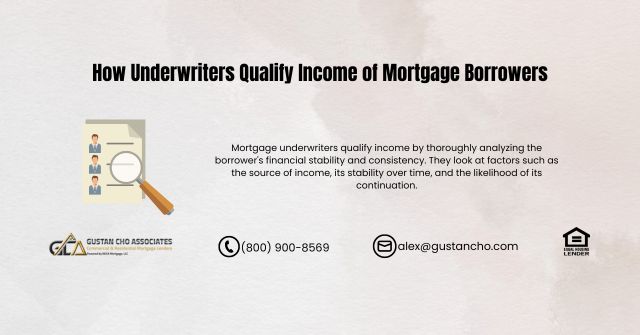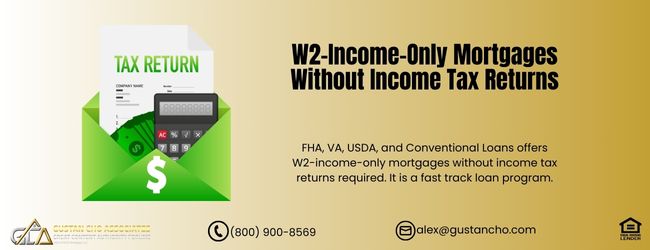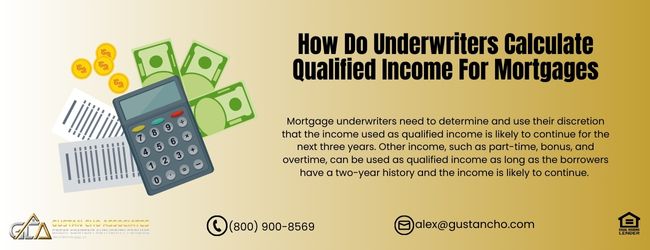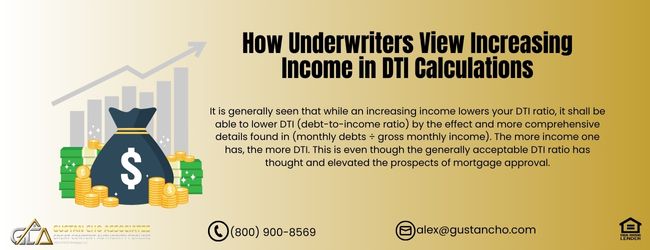How Underwriters Qualify Income of Mortgage Borrowers

This guide covers how underwriters qualify income. One of the most important factors in getting qualified for a residential mortgage loan is credit and income and employment history. Homebuyers with great credit but no qualified income cannot qualify for a mortgage. Homebuyers with documented qualified income but bad credit can qualify for a mortgage as long as they meet the minimum credit scores. Documented income is extremely important when it comes to qualifying for government and conventional loans. There are various ways how underwriters qualify income when underwriting borrowers. In the following paragraphs, we will cover how underwriters qualify income of borrowers.
How Underwriters Qualify Income of Borrowers
How Underwriters Qualify Income: What is Qualified Income?
Cash income is non-existent and does not count in mortgage qualification. Self-employed income requires a minimum of a two-year history of tax returns. If the borrower has consistent or increasing adjusted gross income on their tax returns, then the past two years’ income is averaged. Self-employed borrowers who have declining tax returns, then the lower of the two year’s gross adjusted income is taken into account for income qualification. The two years tax returns are not averaged. One-time write-offs on tax returns can be exempted if proof can be provided. Gaps in employment are allowed. For W-2 employees, mortgage guidelines require six months on the job as a full-time employee if the borrower has been laid off or off work for more than six months. Click here to get more about qualified income
How Underwriters Qualify Income Through Verification of Income
And verification of employment from the employer that the borrower will have continued employment for the immediate and distant future is required. All lenders want to see that the borrower’s continuation of employment is likely to continue for the next three years. There is no job longevity period per mortgage lending guidelines if the borrower has been unemployed or out of work for less than six months. A borrower can be unemployed for five months and get a new full-time job and still qualify for a mortgage loan. This holds true as long as he or she can provide 30-day paycheck stubs. In this article, we will discuss and cover how underwriters qualify income of mortgage borrowers.
How Underwriters Qualify Income and Employment History
Many borrowers get confused when mortgage lenders ask for two-year employment history. Mortgage Guidelines do not require that borrowers be on the same job for the past two years. Borrowers can have multiple jobs for the past two years as well as gaps in employment. Two-year employment history means a two-year work history excluding periods of unemployment.
Being unemployed for over a year is fine. As long as the borrower has a full-time job currently but has a two-year work history borrowers can still qualify for a residential mortgage loan.
As mentioned earlier, borrowers who have been unemployed or out of work for more than six months, need to prove that they have been employed six months as a full-time employee for at least six months in their current full-time job. During the two-year period, borrowers can also have multiple jobs. Two-year employment history just merely means that borrowers need to prove that they had an overall two-year employment work history. Borrowers who have not been employed for two years but were in school full time, time in school is counted as employment history.
Lender Overlays on How Underwriters Qualify Income
Fannie Mae and HUD guidelines state that as long as borrowers are currently employed full time and have been off work less than six months, they qualify for a residential mortgage loan. It also states that if mortgage borrowers have been unemployed for more than six months, they can qualify for a residential mortgage loan as long as they have been full-time employees for at least six months. Each individual mortgage might have its own overlays.
Overlays are mortgage guidelines that are above and beyond those of mortgage guidelines imposed by FHA, VA, USDA, Fannie Mae, and Freddie Mac. Lender overlays are lenders’ own rules that override Fannie Mae and HUD lending guidelines.
Borrowers need to choose a lender that has no lender overlays on this issue if the lender they are consulting with has overlays on gaps in employment. Borrowers who need to qualify for a mortgage with a direct lender with no mortgage overlays on government and conventional loans can contact Gustan Cho Associates at 800-900-8569 or text us for a faster response. Or email us at gcho@gustancho.com. The team at Gustan Cho Associates is available 7 days a week, evenings, weekends, and holidays. Click here for qualify inccome with lender overlays
FAQs: How Underwriters Qualify Income of Mortgage Borrowers
- What factors do underwriters consider when qualifying income? Underwriters analyze the borrower’s financial stability, including the source and stability of income over time, likelihood of continuation, and debt-to-income ratio. They review employment history, salary, bonuses, commissions, rental income, and dividends.
- What documentation is required to verify income? To verify income, underwriters typically require pay stubs covering the most recent 30 days, W-2 forms from the past two years, federal tax returns from the past two years, a profit and loss statement for self-employed borrowers for the year-to-date, and documentation of additional income sources such as bonuses, child support, etc.
- How do underwriters calculate monthly income? For salaried borrowers, income is averaged over the most recent 12-month period. For hourly or commissioned borrowers, income may be averaged over the past two years. Self-employment income is calculated using tax returns and profit/loss statements.
- How do underwriters assess income stability and continuity? Underwriters look for a stable two-year employment history. They may require additional documentation or explanations for gaps or changes in employment. A debt-to-income ratio below 43%- 50% is generally required for approval.
- Can additional income sources be included? Yes, additional income sources such as bonuses, overtime, and investment income can be included if well-documented and expected to continue.
- What is considered qualified income? Qualified income must be documented and verifiable. Cash income is not counted. Self-employed income requires a minimum of two years of tax returns. For self-employed borrowers with consistent or increasing income, the past two years’ income is averaged. If income is declining, the lower of the two years’ income is used.
- Are gaps in employment allowed? Yes, gaps in employment are allowed. For W-2 employees, if the borrower has been laid off or off work for more than six months, they must be employed full-time for at least six months in their current job to qualify.
- How is employment verified? Employment is verified through documentation and direct verification with employers. Lenders want to see that employment will likely continue for three years.
- What are lender overlays? Lender overlays are additional guidelines individual lenders impose that go beyond standard mortgage guidelines. They can affect qualification requirements, including gaps in employment. Borrowers should seek lenders with no overlays if they face stricter requirements from certain lenders.
- How can borrowers with gaps in employment qualify for a mortgage? Borrowers can qualify if they have a full-time job currently and can prove a two-year work history, even if there were periods of unemployment. Time spent in school full-time can also count as employment history.
- What should borrowers do if their lender has overlays on employment gaps? Borrowers should contact a lender with no overlays on government and conventional loans. They can contact Gustan Cho Associates at 800-900-8569 or email gcho@gustancho.com for assistance.
For more information on qualifying for mortgage loans, watch this video or visit Gustan Cho Associates.







Responses